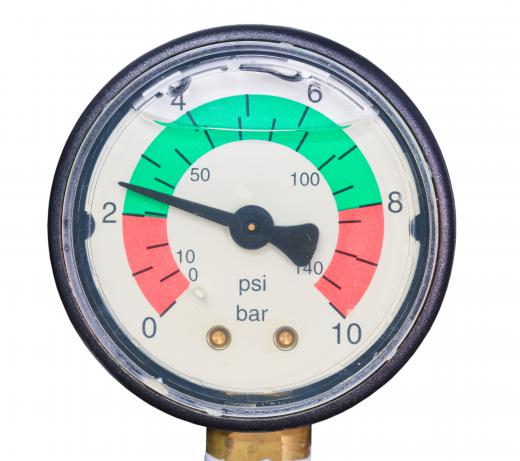A compressor tank is a device used to store compressed air. The air compressor pump is commonly mounted on top of the compressor tank and directs air into the tank via a hardline. The hardline can be made of copper, aluminum or steel, and is designed to withstand high tank pressures. There is typically a relief valve fitted into a bung on the compressor tank that is intended to release if pressure inside of the tank becomes too high. It is customary for the manufacturer of a tank to stamp an expiration date into an information tag mounted somewhere on the tank.
In most applications, the volume of a compressor tank is used to identify the tank's size. There are two distinct types of tanks: vertical and horizontal. This refers to the placement of the motor and pump on the tank and the positioning of the tank on the floor. The vertical tank stands tall, with the motor and compressor perched on top of a mounting plate welded to the top of the tank's narrow end. The horizontal tank has a lower stance and the motor and pump are mounted on a plate that is welded to the top of the long side of the tank.

Heavy, threaded bungs are welded into the compressor tank to provide secure mounting positions for pressure gauges, air inlets and outlets as well as a drain. One bung is reserved for the installation of the pressure-relief valve. Along with the compressor pump and motor plate, other fixtures welded to the compressor tank are legs. The legs are commonly heavy steel units that include a hole to accept a mounting bolt to hold the tank securely in place on a cement floor. An information tag welded to the tank includes information on the tank's manufacturer, manufacture date and volume of the tank.
Water is the enemy of any compressor tank and can cause rust to weaken the tank. A drain is typically located at the lowest point of the tank and is used to periodically empty the accumulated water from the tank. The water found inside of a compressor tank is usually caused from condensation from the heated, compressed air entering the cooler tank. This water builds and is expelled from the tank as water vapor in the air hose. This water can damage air tools, ruin paint jobs and cause damage to the tank's pressure-relief valve and pressure gauges.
